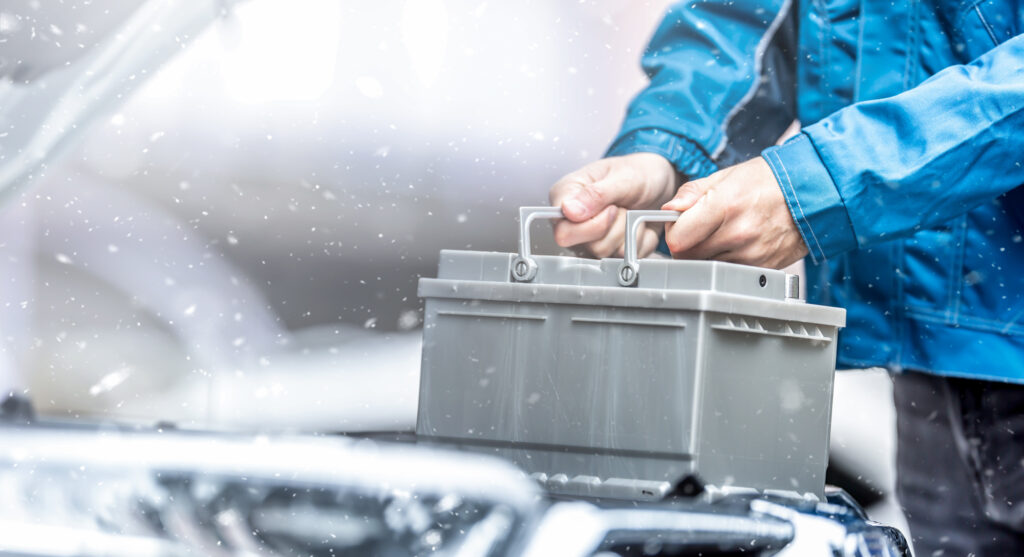Shopping for a new car battery? You might encounter the term “cold cranking amps” or “CCA.” Let’s explore what it means and why it matters when you’re in the market for a battery replacement.
What Does CCA Mean?
The cold cranking amperage (CCA) rating refers to a car battery’s ability to start an engine in cold temperatures. It lets you know how many amps a charged battery produces during a 30-second period while maintaining at least 7.2 volts at a temperature of 0°F (-18°C).
The higher the CCA rating, the greater the battery’s starting power.
When a battery is new, it will have a certain number of cold cranking amps and that number will be displayed as CCA on the battery sticker. Most batteries have from 600 to 900 CCA.
As the battery ages, the CCA (measured with a special tool) will become lower until there isn’t enough CCA for the battery to spin the starter.
Why Is a CCA Rating Important?

Batteries tend to become weaker and operate slower when it’s cold and when the battery gets older. That’s because low temperature and natural attrition both slow down the chemical reactions inside your battery, causing them to produce minimal electrical current.
Engine oil also thickens in cold weather, putting more strain on the engine and requiring more electrical energy from the battery.
If you live in an area where the temperatures sometimes drop below freezing point, you’ll need a battery with a high CCA rating. It will ensure you can start your engine despite the extreme weather conditions.
But even if you’re not living in cold-weather cities, it still pays to know what your battery’s CCA rating is. Also, make sure the replacement complies with your vehicle manufacturer’s recommendations for battery cranking.
What Is Considered a Good CCA Rating for a Car Battery?
Your ride’s recommended CCA rating will depend on your engine’s size, but usually, a CCA rating between 450 and 660 is ideal.
Huge vehicles like buses often require a CCA rating of around 1,000, while a CCA rating of around 450 will do for smaller cars. Rule of thumb; it’s better to have too many CCA than barely enough, but the battery you choose should fit in the battery box and not be so tall that you can’t close the hood.
Aside from your engine’s size, the climate in your area also dictates your battery’s CCA rating. You don’t need a battery with a high CCA rating if you live somewhere warm.
When in doubt, review your owner’s manual or seek advice from a trusted mechanic.
Does a Battery’s CCA Rating Decrease Over Time?
Again, every battery is like an electric fuel tank, and a car battery naturally loses a few CCA over time. That means the amps it produces will decrease as its vehicle racks up mileage. It’s why an old battery might not be able to start your vehicle in cold temperatures.
To prevent starting problems, monitor your car battery’s condition and replace it as needed. Experts recommend replacing the car battery every three to five years.
Where to Find Your Car Battery’s CCA Rating
Most car batteries have a label on top containing crucial information, including their CCA rating.

Other Important Car Battery Ratings You Should Know About
Besides the CCA rating, you must consider the following ratings when shopping for a new battery:
Cranking Amps (CA)
CA refers to the amperage a battery produces at 32 degrees (for 30 seconds) while maintaining a voltage of at least 7.2 volts. It’s similar to the CCA rating, but it’s measured at 32 degrees instead of zero. This rating is important regardless of the climate in your area.
Reserve Capacity (RC)
The RC rating indicates the number of minutes a fully-charged battery operating at 80° F can discharge 25 amps of power and maintain a terminal voltage equal to or greater than 1.75 volts per cell.
This rating gives you an idea of how long a battery can provide voltage. Consider components like windshield wipers, which are powered by the alternator. If the charging system malfunctions, your vehicle will rely on your battery to power these components.
If your car battery has a high RC rating, it can provide power to these components longer. An RC rating also helps you determine the battery’s capability to power components in case of parasitic drain issues.
Amp Hour (AH)
Commonly referred to as C20, this rating determines how much energy is stored in a car battery. It indicates the energy a battery can deliver continuously for 20 hours at 80°F without falling below 10.5 volts. This rating tells you if the battery you’re about to buy can meet your ride’s electrical demands.
Finding the Right Battery for Your Vehicle
Besides battery ratings, here are the other factors you must consider when buying a battery replacement:
Battery Type
Before looking for a replacement battery, determine what type of battery your vehicle is using. If you don’t know that information yet, you can review your owner’s manual or talk to your mechanic.
Size and Terminal Locations
Another important factor in determining whether a great battery is compatible with your ride is its size and terminal location. These specifications can vary depending on the vehicle.
For example, a size 24/24F battery can fit many Honda, Toyota, and Lexus vehicles. However, a size 35 will fit modern Subarus. Make sure you have these things sorted out before buying a battery.
Value for Money
Lastly, make sure that you get your money’s worth. There are many aftermarket brands that sell top-notch batteries, so you can surely find one that fits your make and model.
Any information provided on this Website is for informational purposes only and is not intended to replace consultation with a professional mechanic. The accuracy and timeliness of the information may change from the time of publication.































